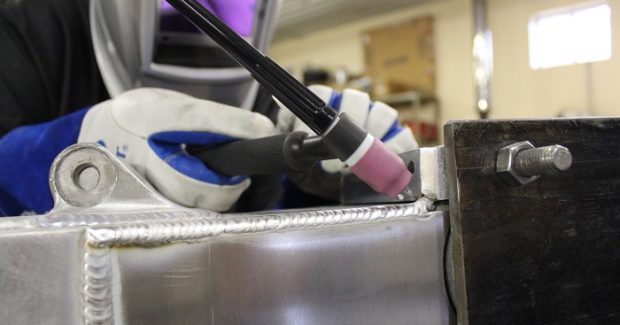Today’s guest post is by Devan DePauw, Welding Engineer TIG Solutions at Miller Electric Mfg. Co.
Anyone who has experience with TIG welding probably can share humorous anecdotes about contorting into an awkward position that required the foot pedal
to be operated between the knees, with an elbow or in some other creative manner.
TIG welding involves a high level of control compared to most welding processes. The operator must accurately manipulate the torch with one hand while carefully adding filler with the other. All of this must be done while simultaneously controlling the heat input.
The current typically is controlled through the use of a foot pedal, which allows the user infinite adjustment, from the machine’s lowest setting to the amperage selected on the machine’s front panel.
Foot pedals are hard to beat when working at a bench or on objects that are easily adjusted to give the best possible access to the joint being welding. However, sometimes the job requires operators to move away from the bench, where this traditional arrangement can become much more difficult or even impossible to use.
Fingertip controls are truly invaluable in these cases. Being able to control the machine’s output with a simple finger motion means there is no need to contort your body beyond what is necessary to get your hands near the joint.
Using a fingertip control also allows for fast tacking while moving around large pieces, and it reduces clutter by eliminating the pedal cord.
There are two basic types of fingertip controls:
TIG Welders with Variable Controls
Variable controls allow the current to be adjusted while welding, just like with a pedal, and are usually actuated by manipulating a knurled wheel. These rotary-motion fingertip controls are available in two configurations that attach to the torch handle:
1. North/south, where the wheel’s axis is perpendicular to the axis of the torch handle. These are great for applications that require fine amperage control.
2. East/west, where the wheel’s axis is parallel to the axis of the torch handle. These are best suited for applications where quick ramp-up and ramp-down of current is needed.
TIG Welders with Switches
Switches do not allow for variable current adjustment and often are employed for simple on/off control of the current. They also can be used in conjunction with the machine’s sequencer function to control initial amperage, ramp-up time, peak amperage, pulsing, ramp-down time and final amperage. There are three main types of switches:
1. Momentary-contact switches are typically a push-button style where the switch is closed only when the button is fully depressed. These are great for applications that require a lot of tack welding or control of the sequencer function. These are often favored when bump welding anodized aluminum.
2. Maintained-contact switches can be found as a single-push button, where the button is pushed to close the circuit and pushed again to open it, or as a dual-button configuration, where the circuit is closed with one button and opened with another. These are useful if your power source does not have a trigger hold function.
3. Rocker switches are a versatile combination of the two described above. The actuator is pushed forward for maintained contact and backward for momentary contact.
Like other welding techniques, the use of a fingertip control will require practice to gain proficiency. Learning to effectively use this accessory can be challenging, but every skill gained is another tool in your professional toolbox. The more talented you become, the more valuable you are in the welding industry.
About Today’s Guest Blogger
Devan DePauw graduated from Ferris State University with a Bachelor of Science in Welding Engineering Technology and is a fixture in his garage, working on old motorcycles whenever time allows.
Click here to purchase Miller Rotary Fingertip Control, North/South, 14-pin Plug


